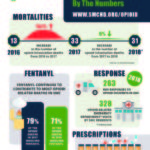Opioid Epidemic Fast Facts
- Opioids include heroin, fentanyl, carfentanil, morphine, and prescription painkillers like OxyContin, Percocet, Vicodin, or Codeine
- Overdoses from heroin and other opioids kill more than 27,000 people per year in the United States
- Signs of an overdose include: blue lips and/or fingertips, pale/grayish skin, unresponsiveness, shallow or slow breathing, and slow or stopped heartbeat
- Opioid misuse destroys lives across the nation, regardless of age, race, wealth, or location
What are Opioids?
Opioids are addictive drugs, man-made or naturally derived from the opium poppy plant. Some opioids are prescription drugs (such as oxycontin, morphine, and pharmaceutical fentanyl), and other opioids are made for the illegal drug market (such as heroin and non-prescribed fentanyl). Even prescription opioids can be misused or distributed illegally. In the past several years, the United States has been experiencing an opioid drug crisis unlike any illicit drug problem the country has seen before. Thousands of people are dying from overdosing on prescription opioids or non-prescribed opioids.
Prescription Opioids
A number of opioids are prescribed by health care providers to relieve pain. While many people benefit from using these medications to manage pain, prescription drugs can be misused, stolen, or illegally distributed to others. These drugs can then cause problems with addiction, injury, and even overdose death. Communities across the country are working to limit the misuse and illegal flow of prescription drugs. Some things people can do to help include: locking up their medication, safely disposing of medications they are no longer using, and getting immediate help for themselves or others if they are concerned about drug misuse or addiction.
Heroin and non-prescribed fentanyl
Heroin, fentanyl, and carfentanil are very powerful opioid drugs responsible for many recent drug overdose deaths. Very small amounts of these can be lethal. Sometimes these opioids are disguised and mixed into the drugs sold on the street, including non-opioid drugs. Drug sellers and drug buyers may not even know that the drugs they are selling or buying have these incredibly lethal opioid substances in them.
Opioid Overdose Deaths
Opioid drugs are causing many people to die from overdoses. An overdose is when the power of the drug overcomes the body. The amount of the drug needed to cause an overdose varies based upon the drug or drug mixture, the person using, and other circumstances. Even the same person who uses the same drug may not overdose one day, but could overdose and die the next day. People die from an opioid overdose because opioid drugs tell the body to stop breathing. Signs that someone may be suffering from an opioid overdose includes: irregular or shallow breathing, snoring/gurgling, or being groggy or unresponsive. Narcan® (naloxone) is a drug used to restore breathing in an opioid overdose and save that person’s life so they have a chance at getting the longer term help they may need.
Additional Resources
- SMCHD | Overdose Prevention Team
- Maryland Dept. of Health | “Before It’s Too Late” campaign
- SAMHSA | Opioid Overdose Prevention Toolkit
- SAMHSA | Prevención de la Sobredosis de Opioides Manual de Instrucción
- Maryland’s Office Of Overdose Response | Community Overdose Action Town Hall Series
